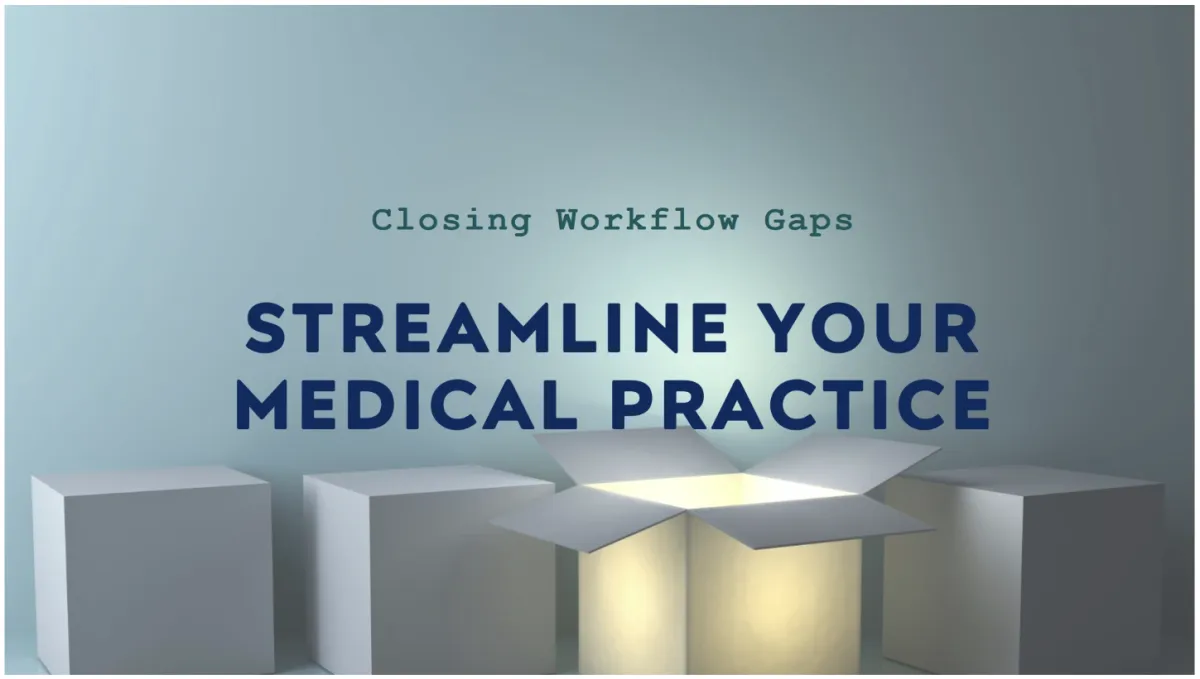
Closing the Workflow Gaps in Your Medical Practice
Improve efficiency and patient care by addressing hidden challenges in your practice workflows.
Running a medical practice is a complex operation, where every process impacts the overall performance and patient satisfaction. However, even the most organized practices can experience workflow gaps that disrupt efficiency, increase stress for your staff, and diminish the patient experience. Identifying and addressing these gaps is key to creating a thriving, well-functioning practice. Let’s explore actionable strategies to close these gaps and enhance your practice’s performance.
1. Conduct a Comprehensive Workflow Audit

Think of your workflow as a relay race: every step must flow seamlessly to achieve optimal results. Start by auditing each stage of your operations:
Patient Intake: Are patients completing their forms before arriving? Delayed intake processes can create bottlenecks that cascade through the day.
Scheduling: Examine whether no-shows or overbookings are disrupting your daily flow. Pre-scheduling during patient visits can prevent chaotic booking patterns.
Clinical Operations: Assess whether exam rooms are properly prepared and stocked ahead of time. Waiting for supplies or room readiness wastes both staff and patient time.
Use this audit to pinpoint areas where inefficiencies are most common, and document these findings to guide your next steps.
2. Gather Insights from Your Team and Patients
Your team and patients are valuable sources of feedback to identify hidden workflow gaps:
Team Feedback: Engage your staff by hosting regular team meetings. Create a “Concerns and Solutions” list to encourage open discussions about pain points and how to fix them.
Patient Surveys: Patients often notice what’s not working. Use quick surveys or informal conversations to gather insights on wait times, communication, and overall satisfaction.
Listening to these perspectives ensures you’re addressing real, not assumed, issues in your workflow.

3. Leverage Data and Metrics to Pinpoint Problems
Data doesn’t lie. Use tools like your EHR system or patient management software to analyze key metrics:
Check-in and Wait Times: Are patients spending too much time in the waiting room? Address delays by streamlining check-in processes and scheduling buffers.
No-Show Rates: Analyze no-show patterns. If certain appointment types or times have high no-show rates, implement automated reminders and confirmation systems.
Billing Errors: Frequent billing issues can frustrate patients and slow revenue cycles. Reviewing error rates and improving staff training on billing processes can resolve this.
These metrics can reveal inefficiencies you might otherwise overlook and provide measurable benchmarks for improvement.
4. Prioritize High-Impact Areas First
Not all gaps are created equal. Some inefficiencies have a greater impact on your practice’s day-to-day operations and patient satisfaction. Focus on addressing these first:
Streamline communication processes by training your front desk staff and ensuring consistent messaging across the team.
Optimize patient scheduling to reduce wait times and avoid double bookings.
Improve room turnover efficiency by implementing checklists to ensure rooms are always ready for the next patient.
These small changes can have an outsized impact, creating immediate wins for both your staff and patients.

5. Implement Solutions Step by Step
Trying to fix everything at once can overwhelm your team and lead to more confusion. Instead, tackle workflow gaps one step at a time. Here are some examples:
Digitize Patient Intake: Implement online forms that patients can complete before arriving. This reduces check-in delays and minimizes manual entry errors.
Automate Appointment Reminders: Use text or email reminders to reduce no-shows and ensure patients arrive prepared for their visits.
Pre-Schedule Follow-Ups: During Report of Findings or other discussions, schedule patients for their next appointments immediately to avoid walk-in congestion.
Once one solution is fully implemented and working, move on to the next. This steady approach builds confidence and momentum within your team.
6. Foster a Culture of Continuous Improvement
Closing workflow gaps isn’t a one-time task—it’s an ongoing process. Empower your team to:
Share observations and suggestions regularly during team meetings.
Celebrate small wins when new processes improve efficiency or patient satisfaction.
Revisit your workflow audit quarterly to identify new areas for improvement.
By embracing a mindset of continuous improvement, your team will stay engaged and committed to providing the best possible patient care.
Smooth Operations, Happy Patients
Workflow gaps are inevitable, but addressing them proactively creates a stronger, more efficient practice. From auditing your processes and leveraging team feedback to prioritizing impactful changes, these steps can transform your operations and improve the overall experience for both patients and staff.
Don’t let inefficiencies slow you down. Take the time to analyze, adapt, and refine your workflows—the results will speak for themselves.
Partner with Med Pro Dojo
At Med Pro Dojo, we specialize in helping medical practices streamline workflows, develop leadership, and overcome operational challenges. Our team provides personalized strategies that empower your practice to thrive, improve team dynamics, and achieve your goals with confidence.
We’re here to serve and support you on your journey to success. Schedule a personalized call with Med Pro Dojo today and discover how we can help transform your practice. Book Here
